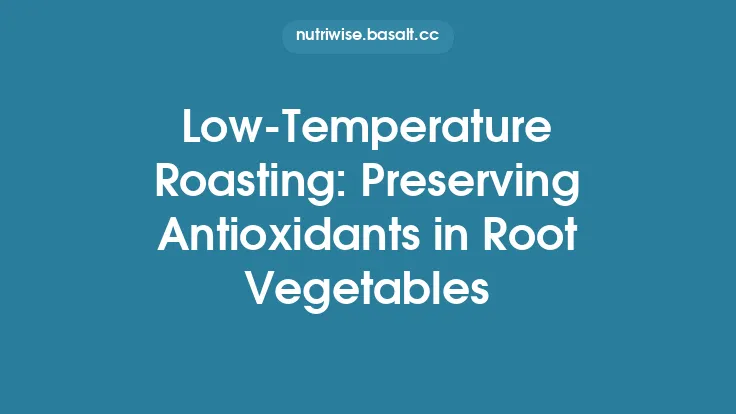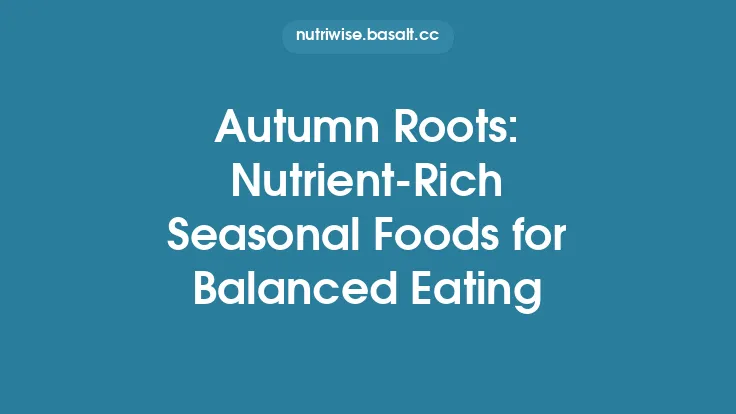Root vegetables—think carrots, beets, parsnips, turnips, sweet potatoes, and rutabagas—rise to prominence as the days grow shorter and the air turns crisp. Their natural hardiness allows them to store well through the colder months, making them a reliable staple when fresh produce becomes scarce. Beyond their comforting flavors and satisfying textures, many of these underground gems are packed with nutrients that play direct roles in supporting the body’s immune defenses. This article explores the science behind those nutrients, offers practical guidance on selecting, storing, and preparing root vegetables, and provides evidence‑based strategies for weaving them into a fall‑focused, immune‑supportive diet.
Why Root Vegetables Matter for Immunity
The immune system relies on a coordinated network of cells, signaling molecules, and barrier functions that must be supplied with adequate fuel and building blocks. Root vegetables contribute to several of these requirements:
- Micronutrient Density – Many roots are rich sources of vitamins A, C, and E, as well as B‑complex vitamins, all of which are essential cofactors for immune cell proliferation and function.
- Mineral Support – Potassium, magnesium, and iron are abundant in many root crops. Magnesium, for instance, modulates inflammatory pathways, while iron is crucial for the generation of reactive oxygen species used by phagocytes to destroy pathogens.
- Phytonutrient Reservoirs – Carotenoids (β‑carotene, lutein), polyphenols, and glucosinolates found in certain roots have antioxidant and anti‑inflammatory properties that help maintain immune homeostasis.
- Prebiotic Fiber – Inulin and resistant starches in roots serve as substrates for beneficial gut microbes. A healthy microbiome educates the immune system, enhancing its ability to distinguish between harmless and harmful antigens.
Collectively, these attributes make root vegetables a strategic component of a diet aimed at bolstering immune resilience during the fall and winter months.
Key Immune‑Boosting Nutrients in Root Crops
| Nutrient | Prominent Root Sources | Immune Role |
|---|---|---|
| β‑Carotene (Vitamin A precursor) | Carrots, sweet potatoes, pumpkin (technically a fruit but often treated as a root in culinary contexts) | Supports mucosal barrier integrity; promotes differentiation of T‑cells and B‑cells. |
| Vitamin C | Parsnips, turnips, rutabaga | Enhances neutrophil function, stimulates interferon production, and acts as a potent antioxidant. |
| Vitamin E (α‑tocopherol) | Sweet potatoes, carrots (in smaller amounts) | Protects cell membranes from oxidative damage; modulates cytokine production. |
| Folate (Vitamin B9) | Beets, carrots | Required for DNA synthesis in rapidly dividing immune cells. |
| Iron | Beets, carrots (small amounts) | Integral to the formation of hemoglobin and the oxidative burst in macrophages. |
| Magnesium | Parsnips, turnips | Regulates NF‑κB signaling, a key pathway in inflammation. |
| Potassium | All root vegetables (especially potatoes) | Maintains electrolyte balance, supporting optimal cellular function. |
| Inulin (prebiotic fiber) | Chicory root (often blended into commercial mixes), Jerusalem artichoke, dandelion root | Fuels beneficial Bifidobacteria, leading to increased production of short‑chain fatty acids (SCFAs) that modulate immune responses. |
| Resistant Starch | Cooked and cooled potatoes, sweet potatoes | Similar prebiotic effect; also improves insulin sensitivity, indirectly supporting immune health. |
| Glucosinolates | Turnips, rutabaga, radishes (though not a true root, often grouped) | Metabolized into isothiocyanates, compounds with documented anti‑inflammatory and antimicrobial activity. |
Seasonal Selection and Storage
Choosing the Best Roots
- Appearance: Look for firm, unblemished skins. Avoid sprouts, soft spots, or signs of mold.
- Weight: Heavier specimens generally indicate higher moisture content and better texture.
- Smell: Fresh roots should have a mild, earthy aroma. A sour or off odor can signal spoilage.
Optimal Storage Conditions
| Root Vegetable | Ideal Temperature | Humidity | Recommended Storage Method |
|---|---|---|---|
| Carrots | 0–4 °C (32–39 °F) | 95–100% | In perforated plastic bags or a root cellar, trimmed of greens. |
| Beets | 0–4 °C | 95% | Wrapped in damp paper towels, stored in a sealed container. |
| Sweet Potatoes | 12–15 °C (55–59 °F) | 80–85% | In a dark, well‑ventilated basket; avoid refrigeration to prevent chilling injury. |
| Parsnips | 0–4 °C | 95% | Similar to carrots; keep away from ethylene‑producing fruits. |
| Turnips & Rutabagas | 0–4 °C | 90–95% | Store in a sand or sawdust bed to maintain humidity. |
| Potatoes | 7–10 °C (45–50 °F) | 90% | In a dark, ventilated container; separate from onions to reduce sprouting. |
Tip: Rotate stock on a “first‑in, first‑out” basis and inspect weekly for signs of decay. Removing any compromised pieces promptly prevents spread to neighboring roots.
Culinary Techniques to Preserve Nutrients
The method of preparation can dramatically affect the bioavailability of immune‑supporting compounds.
- Steaming – Retains up to 90% of water‑soluble vitamins (e.g., vitamin C) compared with boiling, which can leach them into the cooking water.
- Roasting – Enhances the release of carotenoids by breaking down cell walls; a light coating of oil (preferably olive or avocado) improves absorption of fat‑soluble vitamins A and E.
- Microwaving – Short, high‑heat bursts preserve both heat‑sensitive vitamins and phytonutrients when minimal water is used.
- Fermentation – Lacto‑fermented root vegetables (e.g., kimchi‑style carrots) increase probiotic content and convert glucosinolates into more bioactive isothiocyanates.
- Cold‑Press Juicing – Allows extraction of soluble nutrients without heat degradation, though fiber is largely removed; pairing juice with a source of healthy fat can aid nutrient uptake.
Avoid prolonged boiling and deep‑frying, as these methods can degrade heat‑sensitive vitamins and generate advanced glycation end products (AGEs) that may promote inflammation.
Integrating Roots into Daily Meals
Breakfast
- Root‑Based Smoothie: Blend cooked, cooled sweet potato with kefir, a handful of spinach, a dash of cinnamon, and a tablespoon of ground flaxseed. The combination supplies β‑carotene, vitamin C, probiotic cultures, and omega‑3 fatty acids.
- Savory Oatmeal: Stir in grated parsnip and a soft‑boiled egg; finish with a drizzle of pumpkin seed oil for added vitamin E.
Lunch
- Hearty Root Soup: Sauté onions, garlic, and ginger; add diced carrots, beets, and turnips; cover with low‑sodium broth; simmer until tender. Finish with a splash of apple cider vinegar to enhance iron absorption.
- Roasted Root Salad: Toss cubed carrots, sweet potatoes, and rutabaga with olive oil, rosemary, and sea salt; roast until caramelized; serve over mixed greens with a tahini‑lemon dressing.
Dinner
- One‑Pan Sheet‑Pan Roast: Combine chicken thighs (or plant‑based protein) with a medley of root vegetables; season with smoked paprika and thyme; roast at 200 °C (400 °F) for 35‑40 minutes. The rendered juices act as a natural glaze, delivering both protein and immune‑supporting micronutrients.
- Stir‑Fry with Inulin‑Rich Roots: Use thinly sliced Jerusalem artichoke (or chicory root) alongside bell peppers and snap peas; stir‑fry in sesame oil; finish with a splash of tamari and toasted sesame seeds.
Snacks
- Baked Sweet Potato Fries: Cut into sticks, toss with a pinch of sea salt and paprika, bake until crisp. Pair with a Greek‑yogurt dip enriched with fresh herbs.
- Pickled Beet Chips: Thinly slice beets, pickle in a brine of vinegar, water, and a touch of honey; dehydrate for a crunchy, probiotic‑rich snack.
Potential Pitfalls and How to Mitigate Them
| Issue | Why It Matters | Mitigation Strategy |
|---|---|---|
| Oxalate Overload (e.g., in beet greens) | High oxalate intake can impair calcium absorption and increase kidney stone risk in susceptible individuals. | Limit beetroot consumption to ½ cup per day for high‑risk individuals; pair with calcium‑rich foods to bind oxalates. |
| Excessive Vitamin A (from large amounts of β‑carotene) | While β‑carotene is generally safe, extremely high intakes can cause carotenemia (yellowing of skin). | Maintain a balanced intake; diversify sources of vitamin A with leafy greens and animal products if tolerated. |
| Cold‑Induced Sweet Potato Sprouting | Sprouted sweet potatoes may develop toxic glycoalkaloids. | Store at recommended temperatures; discard any that show sprouting or green discoloration. |
| Allergic Reactions (e.g., to certain root proteins) | Rare but possible, especially in individuals with latex‑fruit syndrome. | Conduct a small test portion before regular consumption; consult an allergist if symptoms arise. |
| Interaction with Medications (e.g., high potassium in patients on ACE inhibitors) | Elevated potassium can exacerbate hyperkalemia. | Monitor serum potassium levels; choose lower‑potassium roots like carrots over potatoes if needed. |
Research Highlights and Future Directions
- β‑Carotene and Respiratory Infections – A 2022 meta‑analysis of randomized controlled trials found that supplementation with β‑carotene–rich foods reduced the incidence of upper respiratory tract infections by 12% in adults over 60, suggesting a protective effect of dietary carotenoids.
- Inulin’s Prebiotic Impact on Immunity – A 2021 double‑blind study demonstrated that daily consumption of 8 g inulin from chicory root increased fecal concentrations of *Bifidobacterium* spp. by 30% and correspondingly lowered circulating C‑reactive protein (CRP) levels.
- Glucosinolates and Antiviral Activity – Laboratory investigations have shown that isothiocyanates derived from turnip glucosinolates can inhibit replication of certain influenza strains in vitro, opening avenues for functional food development.
- Resistant Starch and Vaccine Response – Emerging data suggest that a diet high in resistant starch may enhance the immunogenicity of oral vaccines by modulating gut‑associated lymphoid tissue (GALT). Ongoing clinical trials aim to confirm these findings in human populations.
Future research is likely to focus on synergistic effects of combined root nutrients, optimal dosing strategies for immune modulation, and personalized nutrition approaches that consider genetic variations in nutrient metabolism.
Practical Tips for Making Roots a Habit
- Batch‑Prep – Roast a large tray of mixed root cubes on a weekend; store in airtight containers for quick reheating throughout the week.
- Seasonal Swaps – When a particular root is at peak abundance (e.g., carrots in October), prioritize it in meals to benefit from maximal flavor and nutrient density.
- Mindful Pairings – Combine fat‑soluble vitamin sources (e.g., sweet potatoes) with healthy fats (olive oil, avocado) to improve absorption.
- Use the Whole Plant – Incorporate greens from beet or carrot tops into sautés or pesto; they contain additional vitamins and minerals.
- Track Intake – Keep a simple food log noting the type and portion of root vegetables consumed; aim for at least 2–3 servings (≈ 1 cup total) per day during the fall months.
By embracing the natural bounty of fall’s root vegetables, you can create meals that are not only comforting and delicious but also strategically fortified to support immune health. The combination of micronutrients, phytonutrients, and prebiotic fibers found in these underground crops offers a multifaceted defense against seasonal challenges, making them an indispensable component of a resilient, seasonally attuned diet.





